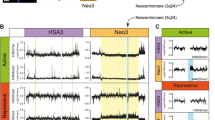Abstract
HETEROCHROMATIN is a cytologically visible form of condensed chromatin capable of repressing genes in eukaryotic cells. For the yeast Saccharomyces cerevisiae, despite the absence of observable heterochromatin, there is genetic and chromatin structure data which indicate that there are heterochromatin-like repressive structures1,2. Genes experience position effects at the silent mating loci and the telomeres, resulting in a repressed state that is inherited in an epigenetic manner. The histone H4 amino terminus is required for repression at these loci3,4. Additional studies have indicated that the histone H3 N terminus is not important for silent mating locus repression5,6, but redundancy of repressive elements at the silent mating loci may be responsible for masking its role. Here we report that histone H3 is required for full repression at yeast telomeres and at partially disabled silent mating loci, and that the acetylatable lysine residues of H3 play an important role in silencing.
This is a preview of subscription content, access via your institution
Access options
Subscribe to this journal
Receive 51 print issues and online access
$199.00 per year
only $3.90 per issue
Buy this article
- Purchase on Springer Link
- Instant access to full article PDF
Prices may be subject to local taxes which are calculated during checkout
Similar content being viewed by others
References
Laurenson, P. & Rine, J. Microbiol. Rev. 56, 543–560 (1992).
Thompson, J. S., Hecht, A. & Grunstein, M. Cold Spring Harb. Symp. quant. Biol. 58, 247–256 (1993).
Kayne, P. S. et al. Cell 55, 27–39 (1988).
Aparicio, O. M., Billington, B. L. & Gottschling, D. E. Cell 66, 1279–1287 (1991).
Morgan, B. A., Mittman, B. A. & Smith, M. M. Molec. cell. Biol. 11, 4111–4120 (1991).
Mann, R. K. & Grunstein, M. EMBO J. 11, 3297–3306 (1992).
Gottschling, D. E., Aparicio, O. M., Billington, B. L. & Zakian, V. A. Cell 63, 751–762 (1990).
Johnson, L. M., Fisher-Adams, G. & Grunstein, M. EMBO J. 11, 2201–2209 (1992).
van Holde, K. E. Chromatin (Springer, Berlin, 1989).
Turner, B. M., Birley, A. J. & Lavender, J. Cell 69, 375–384 (1992).
Braunstein, M., Rose, A. B., Holmes, S. G., Allis, C. D. & Broach, J. R. Genes Dev. 7, 592–604 (1993).
Thompson, J. S., Johnson, L. M. & Grunstein, M. Motec. cell. Biol. 14, 446–455 (1994).
Pillus, L. & Rine, J. Cell 59, 637–647 (1989).
Johnson, L. M., Kayne, P. S., Kahn, E. S. & Grunstein, M. Proc. natn. Acad. Sci. U.S.A. 87, 6286–6290 (1990).
Boeke, J. D., LaCroute, F. & Fink, G. R. Molec. Gen. Genet. 197, 345–346 (1984).
Schuster, T., Han, M. & Grunstein, M. Cell 45, 445–451 (1986).
Kohrer, K. & Domdey, J. Meth. Enzym. 194, 398–405 (1991).
Durrin, L. K., Mann, R. K., Kayne, P. S. & Grunstein, M. Cell 65, 1023–1031 (1991).
Author information
Authors and Affiliations
Rights and permissions
About this article
Cite this article
Thompson, J., Ling, X. & Grunstein, M. Histone H3 amino terminus is required for telomeric and silent mating locus repression in yeast. Nature 369, 245–247 (1994). https://doi.org/10.1038/369245a0
Received:
Accepted:
Issue Date:
DOI: https://doi.org/10.1038/369245a0
This article is cited by
-
Chemical biology of Histone acetyltransferase natural compounds modulators
Molecular Diversity (2011)
-
Silent chromatin at the middle and ends: lessons from yeasts
The EMBO Journal (2009)
-
UV sensitive mutations in histone H3 in Saccharomyces cerevisiae that alter specific K79 methylation states genetically act through distinct DNA repair pathways
Current Genetics (2008)
-
Genome-wide patterns of histone modifications in yeast
Nature Reviews Molecular Cell Biology (2006)
-
Histone acetylation and deacetylation in yeast
Nature Reviews Molecular Cell Biology (2003)
Comments
By submitting a comment you agree to abide by our Terms and Community Guidelines. If you find something abusive or that does not comply with our terms or guidelines please flag it as inappropriate.



